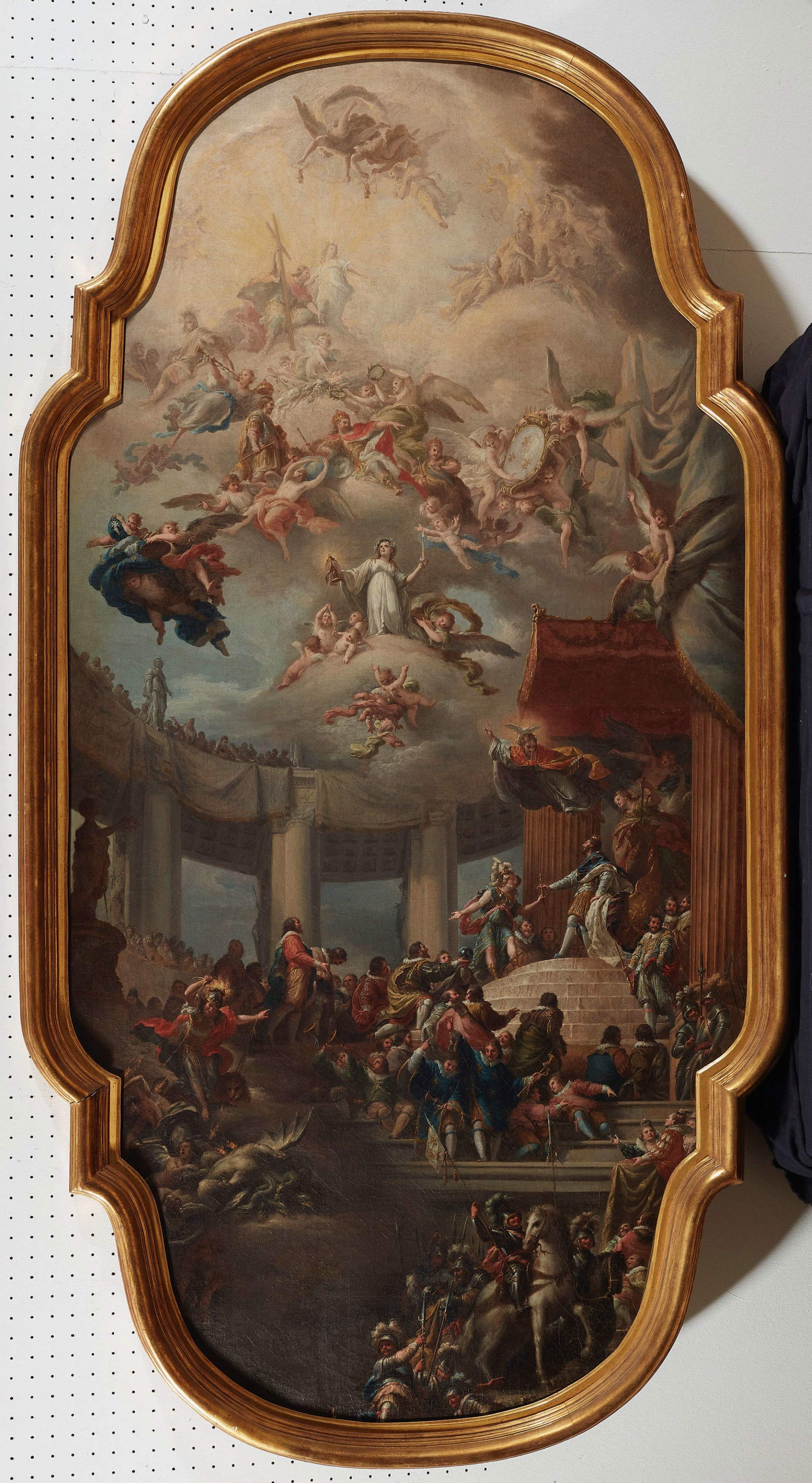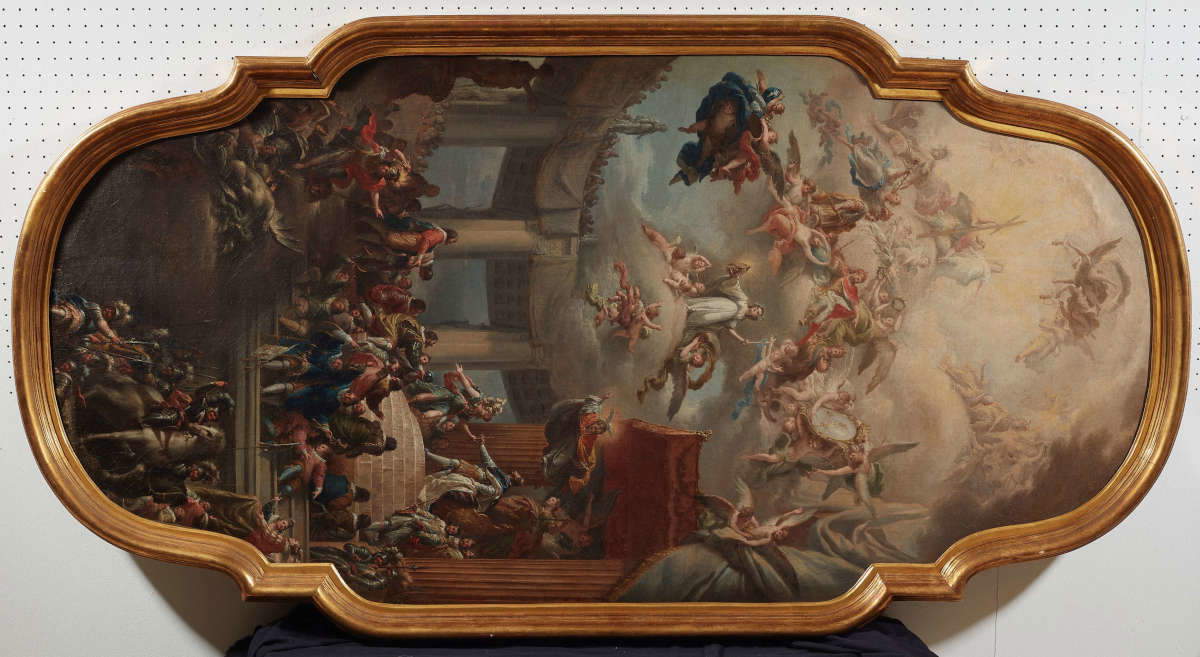The Reggia di Caserta welcomes back one of the most significant works of 18th-century Neapolitan painting thanks to an acquisition: The Apotheosis of the Bourbon Dynasty by Fedele Fischetti (Naples, 1732 - 1792), a classicist masterpiece and emblematic testimony to Vanvitelli’s artistic season, returns to the Reggia’s holdings thanks to a collaboration between the auction house Lempertz, the Ministry of Culture ’s General Directorate for Museums and the offices of the monumental complex.
The acquisition, officially announced today, represents one of the most important recent restitutions to Italian public collections. The work was purchased in Cologne through private negotiations, with funding from the General Directorate of Museums, and subsequently underwent restoration. The painting will be one of the protagonists of the exhibition Tutto torna!, which will open next Oct. 22 in the spaces of the Royal Palace of Caserta, with the aim of presenting to the public the most significant new acquisitions and restitutions to the museum heritage of the Bourbon complex.
The return of the canvas marks a significant moment in the history of the museum and in the broader policy of recovering works related to the original decoration envisioned by Luigi Vanvitelli. The Apotheosis of the Bourbon Dynasty is in fact considered one of the most complete and refined testimonies of the figurative program conceived by the architect for the Throne Room, the symbolic and representative heart of the Royal Palace. The work, created by Fedele Fischetti at the height of his artistic maturity, represents the apogee of his production and a pinnacle of Neapolitan classicist painting in the second half of the 18th century.
Fischetti, who was born in Naples in 1732 and trained in the cultured and cosmopolitan milieu of the Bourbon court, was one of the main interpreters of decorative painting inspired by Vanvitellian models. As art historian Nicola Spinosa recalls, his work constituted “the most appropriate and organic pictorial and decorative completion of Vanvitellian architecture,” capable of blending formal rigor, allegorical symbolism and compositional balance.
The work can be considered a preparatory sketch or “stain” for a fresco that Vanvitelli had commissioned from Fischetti in 1772 for the Baciamano Hall of the Reggia. The fresco, however, was never realized, and the remaining painting today constitutes the only tangible evidence of that decorative project that was never completed. From an iconographic point of view, The Apotheosis of the Bourbon Dynasty represents a complex and articulate interweaving of moral and political allegories. Fischetti imagines a grandiose celestial setting in which the Virtue of Truth holds a lion, symbol of strength tamed by reason, on a leash and defeats the Vices of Envy and Backbiting. Athena, the emblem of Merit, holds out her scepter to the ruler, accompanied behind her by Justice and Faith, toward which the king turns his gaze following the direction of Divine Wisdom.

The composition culminates in the depiction of angels raising the Bourbon coat of arms in glory and crowning the previous sovereigns with laurel, in a visual triumph of dynastic continuity and moral legitimacy. The whole, dominated by a warm and vibrant light, is in the tradition of the great Baroque apotheosis, but filtered through the classical measure and balanced taste of Neoclassicism.
Particularly interesting is the figure of the king, barely hinted at in features but recognizable by analogy with the iconography of St. Ferdinand. According to scholars, Fischetti intended to depict the sovereign precisely in the guise of the saint of the same name, in a parallelism between royal and Christian virtue that evokes the religious apotheosis of the cycles of the House of Austria, already addressed by the artist in previous works. The scene, therefore, combines political triumph and moral reflection, expressing that “classical direction” that reworks the highest tradition of Neapolitan painting in a modern key.
The acquisition of the work was made possible by the ongoing efforts of the auction house Lempertz, a historic international institution based in Cologne, which for years has maintained a constructive dialogue with Italian museum institutions. On this occasion, Lempertz collaborated with the Direzione Generale Musei and the offices of the Reggia di Caserta to ensure a transparent and timely intervention, making it possible to bring back to Italy a painting of exceptional historical and symbolic value.
“During a business trip I saw the Fischetti model hanging on a wall, which I found extraordinary,” emphasizes Carlotta Mascherpa, Old Master Specialist and Director of Lempertz Italy. “The owner already had the information and I knew immediately that it was a painting that absolutely had to go back to Italy. Sometimes it happens that works that have been unknown or dispersed for centuries resurface on the market, and only through their entry into the market circuit can they find the most appropriate placement. This is not the first time Lempertz has collaborated with institutions, and in Italy (the Einstein family, owner of the auction house, donated a cross stolen from the church of San Pantalone in Venice, allowing it to be relocated to its original position. In addition, through a pre-emptive auction and subsequent private sale, the Abruzzo National Museum in L’Aquila was able to regain possession of four tablets by the Master of Campo di Giove, which left Italy under mysterious circumstances during the early 20th century. As an Italian citizen, I feel the deontological need to encourage the return of exceptional works to Italian public collections, despite the difficulties that bureaucracy entails.”
The General Directorate of Museums, through its direct funding, supported the operation as it is consistent with the mission of protecting, acquiring and enhancing the national cultural heritage. The acquisition is not only an act of material recovery, but also a form of recomposition of the iconographic and architectural narrative imagined by Vanvitelli for the royal palace. Indeed, with The Apotheosis of the Bourbon Dynasty, the Royal Palace of Caserta recovers not only an artistic masterpiece, but also a fundamental piece of its historical identity. And it also bears witness to a virtuous collaboration between the public and private sectors.
 |
| A new work for the Royal Palace of Caserta: acquired the Apotheosis of the Bourbons by Fedele Fischetti |
Warning: the translation into English of the original Italian article was created using automatic tools. We undertake to review all articles, but we do not guarantee the total absence of inaccuracies in the translation due to the program. You can find the original by clicking on the ITA button. If you find any mistake,please contact us.